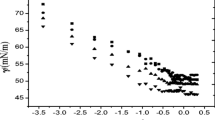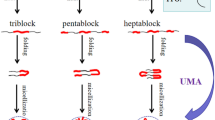Abstract
The diffusion and adsorption behaviors of a few PEO-PPO-PEO type triblock copolymers, namely, Pluronics® L62, L64, F68, F87, and F88 at solid-liquid and liquid-liquid interfaces is investigated using water penetration through packed PTFE powder, dynamic surface tension (DST), interfacial tension (IFT), dynamic light scattering (DLS), and contact angle measurements. The water penetration and DST data reveal that the diffusivity of these block copolymers to the interface decreases with increase in the PEO molecular weight of the polymer and is governed by adsorption of surfactant molecules at the interface through PPO blocks. The DST and IFT results reveal faster diffusion to the interface for low molecular L62 and L64. The adsorption behaviors at isopropyl myristate (IPM)-water and PTFE-water interfaces are in good agreement, where lower molecular weight and lower PEO content favor the faster diffusion kinetics. The size of the formed emulsion droplets in presence of different surfactant molecules is measured using DLS, which shows bigger emulsion droplet size for high molecular weight and PEO containing polymer F88. Thus, it was found that surfactant having lower DST will result in higher wettability, lower contact angle, and lower interfacial tension.

ᅟ






Similar content being viewed by others
References
Somasundaran P (2006) Encyclopedia of surface and colloid science. Vol-2. CRC press, Boca Raton
Tarcha P (1990) Polymers for controlled drug delivery. CRC press, Boca Raton
Zhihao Y, Ravi S, Jettrey IH (2002) Continuous ink jet printing process, US 6364469
Jun Loh X (2016) Polymers for personal care products and cosmetics. Vol. 20. Royal Society of Chemistry, London
Kabanov AV, Lemieux P, Vinogradov S, Alakhov V (2002) Pluronic block copolymers: novel functional molecules for gene therapy. Adv Drug Deliv Rev 54:223–233
Chu B, Zhou Z (1996) Phys Chem of polyoxyalkylene block copolymer surfactants. In: Nace VM (ed) Nonionic surfactants: polyoxyalkylene block copolymers. Marcel Dekker, New York, pp 67–143
Liu X, Wu D, Turgman-Cohen S, Genzer J, Theyson TW, Rojas OJ (2010) Adsorption of a nonionic symmetric triblock copolymer on surfaces with different hydrophobicity. Langmuir 26:9565–9574
Nelson A, Cosgrove T (2005) Small-angle neutron scattering study of adsorbed pluronic tri-block copolymers on laponite. Langmuir 21:9176–9182
Liou YB, Tsay RY (2011) Adsorption of PEO-PPO-PEO triblock copolymers on a gold surface. J Taiwan Inst Chem Eng 42:533–540
Li Y, Liu H, Song J, Rojas OJ, Hinestroza JP (2011) Adsorption and association of a symmetric PEO-PPO-PEO triblock copolymer on polypropylene, polyethylene, and cellulose surfaces. ACS Appl Mater Interface 3:2349–2357
Nejadnik MR, Olsson ALJ, Sharma PK, Van Der Mei HC, Norde W, Busscher HJ (2009) Adsorption of Pluronic F-127 on surfaces with different hydrophobicities probed by quartz crystal microbalance with dissipation. Langmuir 25:6245–6249
Au SH, Kumar P, Wheeler AR (2011) A new angle on pluronic additives: advancing droplets and understanding in digital microfluidics. Langmuir 27:8586–8594
Alexandridis P, Tsianou M (2011) Block copolymer-directed metal nanoparticle morphogenesis and organization. Eur Polym J 47:569–583
Ramírez P, Stocco A, Muñoz J, Miller R (2012) Interfacial rheology and conformations of triblock copolymers adsorbed onto the water-oil interface. J Colloids Interface Sci 378:135–143
Pérez-Mosqueda LM, Maldonado-Valderrama J, Ramírez P, Cabrerizo-Vílchez MA, Muñoz J (2013) Interfacial characterization of Pluronic PE9400 at biocompatible (air-water and limonene-water) interfaces. Col Surf B Biointerface 111:171–178
Shah V, Bharatiya B, Shah DO, Mukherjee T (2015) Correlation of dynamic surface tension with sedimentation of PTFE particles and water penetration in powders. Langmuir 31:13725–13733
Bonfillon A, Sicoli F, Langevin D (1994) Dynamic surface tension of ionic surfactant solutions. J Colloids Interface Sci. 168:497–504
Rosen MJ (2004) Surfactants and interfacial phenomena. John Wiley & Sons Inc, Hoboken
Eastoe JUU, Dalton JSS (2000) Dynamic surface tension and adsorption mechanisms of surfactants at the air-water interface. Adv Colloids Interface Sci 85:103–144
Patist A, Oh SG, Leung R, Shah DO (2001) Kinetics of micellization: its significance to technological processes, in: Colloids and Surfaces, Elsevier Science Publishers BV, pp. 3–16
Buckton G, Machiste E (1997) Differences between dynamic and equilibrium surface tension of poly (oxyethylene)–poly (oxypropylene)–poly (oxyethylene) block copolymer surfactants (poloxamers). J Pharm Sci 86:163–166
Liu X, Zhao Y, Li Q, Niu J (2016) Surface tension, interfacial tension and emulsification of sodium dodecyl sulfate extended surfactant. Colloids Surf. A Physicochem. Eng. Asp. 494:201–208
Joos P, Rillaerts E (1981) Theory on the determination of the dynamic surface tension with the drop volume and maximum bubble pressure methods. J Colloid Interface Sci 79:96–100
Chaudhuri RG, Paria S (2009) Dynamic contact angles on PTFE surface by aqueous surfactant solution in the absence and presence of electrolytes. J Colloids Interface Sci 337:555–562
Shah V, Bharatiya B, Shukla A, Shah DO, Mukherjee T (2016) Adsorption of nonionic Brij and Tween surfactants at PTFE-water and air-water interfaces: investigations on wetting, dispersion stability, foaming and drug solubilization. Colloids Surf A Physicochem Eng Asp 508:159–166
Standnes DC, Austad T (2002) Wettability alteration in chalk 2. Mechanism for wettability alteration from oil-wet to water-wet using surfactants. J Pet Sci Eng 28:123–143
Kiss É, Erdélyi K, Szendrö I, Vargha-Butler EI (2004) Adsorption and wetting properties of pluronic block copolymers on hydrophobic surfaces studied by optical waveguide lightmode spectroscopy and dynamic tensiometric method. J Adhes 80:815–829
Zdziennicka A, Szymczyk K, Jan B (2009) Correlation between surface free energy of quartz and its wettability by aqueous solutions of nonionic , anionic and cationic surfactants. J Colloids Interface Sci 340:243–248
Biswal NR, Paria S (2012) Wetting of PTFE and glass surfaces by aqueous solutions of cationic and anionic double-chain surfactants. Ind Eng Chem Res 51:10172–10178
Zhou ZH, Zhang Q, Wang HZ, Xu ZC, Zhang L, Liu DD, Zhang L (2016) Wettability of a PTFE surface by aqueous solutions of zwitterionic surfactants: effect of molecular structure. Colloids Surf. A Physicochem. Eng. Asp. 489:370–377
Ngan KH, Ioannou K, Rhyne LD, Angeli P (2011) Effect of glycerol addition on phase inversion in horizontal dispersed oil-water pipe flows. Exp. Thermal Fluid Sci 35:628–635
Rahn-Chique K, Urbina-Villalba G (2017) Dependence of emulsion stability on particle size: relative importance of drop concentration and destabilization rate on the half lifetimes of O/W nanoemulsions. J Disp Sci Technol 38:167–179
Takamura K, Fischer H, Morrow NR (2012) Physical properties of aqueous glycerol solutions. J Pet Sci Eng 99:50–60
Kale NJ, Allen LV (1989) Studies on microemulsions using Brij 96 as surfactant and glycerin, ethylene glycol and propylene glycol as cosurfactants. Int J Pharm 57:87–93
Bak A, Podgarska W (2016) Interfacial and surface tensions of toluene/water and air/water systems with nonionic surfactants Tween 20 and Tween 80. Colloids Surf. A Physicochem. Eng. Asp. 504:414–425
Kronberg B, Holmberg K, Lindman B (2014) Surface chemistry of surfactants and polymers. John Wiley & Sons, Inc, Chichester
Zana R (2015) Dynamics of surfactant self-assemblies: micelles, microemulsions, vesicles and lyotropic phases (Vol. 125). CRC press, Boca Raton
Sharma M, Bharatiya B, Mehta K, Shukla A, Shah DO (2014) Novel strategy involving surfactant-polymer combinations for enhanced stability of aqueous teflon dispersions. Langmuir 30:7077–7084
Chappat M (1994) Some applications of emulsions. Colloids Surf. A Physicochem. Eng. Asp. 91:57–77
Driscoll DF (2002) The significance of particle/globule-sizing measurements in the safe use of intravenous lipid emulsions. J. Dispers. Sci. Technol. 23:679–687
Wulff-Pérez M, Torcello-Gómez A, Gálvez-Ruíz MJ, Martín-Rodríguez A (2009) Stability of emulsions for parenteral feeding: preparation and characterization of o/w nanoemulsions with natural oils and Pluronic f68 as surfactant. Food Hydrocoll 23:1096–1102
Silva PS, Zhdanov S, Starov VM, Holdich RG (2016) Spontaneous emulsification of water in oil at appreciable interfacial tensions. Colloids Surf. A Physicochem. Eng. Asp. 521:141–146
Magdassi S, Frank SG (1990) Formation of oil in glyceroivwater emulsions: effect of surfactant ethylene oxide content. J. Dispers. Sci. Technol. 11:519–528
Lopes JR, Loh W (1998) Investigation of self-assembly and micelle polarity for a wide range of ethylene oxide-propylene oxide-ethylene oxide block copolymers in water. Langmuir 14:750–756
Gotchev G, Kolarov T, Khristov K, Exerowa D (2011) Electrostatic and steric interactions in oil-in-water emulsion films from Pluronic surfactants. Adv. Colloid Interface Sci 168:79–84
Acknowledgements
V.S. and B.B. thank the Department of Science and Technology (DST), New Delhi, India, for a research grant in form of DST-Fast Track project no. SB/FT/CS-080/2013.
Author information
Authors and Affiliations
Corresponding author
Ethics declarations
Conflict of interest
The authors declare that they have no conflict of interest.
Rights and permissions
About this article
Cite this article
Shah, V., Bharatiya, B. & Shah, D.O. Effect of molecular weight and diffusivity on the adsorption of PEO-PPO-PEO block copolymers at PTFE-water and oil-water interfaces. Colloid Polym Sci 296, 1333–1340 (2018). https://doi.org/10.1007/s00396-018-4346-3
Received:
Revised:
Accepted:
Published:
Issue Date:
DOI: https://doi.org/10.1007/s00396-018-4346-3




